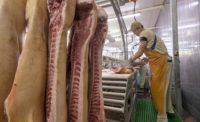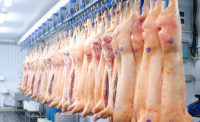Tech | Plant of the Future
Deli Plant of the Future

The pandemic had a profound impact on our food spending, and we have seen a dramatic increase in dining at home. An influx of new shoppers in the grocery stores are making their food, especially lunches, at home, and they seek flavorful deli meat choices that are convenient, healthy and, above all, safe. While many continue to shop with a careful eye on the handling of their food behind the deli counter, many more look for unique packaging that offers visually appealing and tasty choices that are either individually portioned or in recloseable packaging and presumably packaged under USDA supervision. Consumers are also keen to change up the menu with new flavors and formats, where available.
This has created an important paradigm shift in many aspects of the deli industry. During the pandemic, a large number of major meat processors shut down their lines because of rapid spread of the virus within their operations. The result was shortages in supply of both raw material and further processed meats. Many others had to slow their lines to accommodate greater distancing between employees until other mitigation efforts could be applied or implemented. As a result, many processors have learned lessons that will carry them into the future. First and foremost, the ability to be flexible in the face of changing demands — namely shrinking foodservice and the surge in retail demand. Over the next few years we may see more dramatic demand shifts, potentially back to foodservice, and then a new balance between foodservice and retail. Is the deli plant of the future ready for these shifts?
A plant’s ability to be nimble and innovative will be the two traits that carry them farthest into the future.
Equipment and Personnel
No one can deny escalating labor costs, but those who invested in robotics certainly saw a significant return on their investment during this period. And it wasn’t just the equipment, but the investment in a more advanced and highly trained labor force to keep that same equipment running at its highest level of efficiency.
The reason to work toward a highly automated facility is two-fold. First is worker complacency. A machine rarely gets tired and the newest items need less maintenance. However, to ensure these high-tech improvements deliver to their maximum, those responsible must look at their new machinery as a partner that requires constant oversight. The moment we allow the machine to do all the work is when we stop caring about the final product.
Second, when investing in higher speed or fully automated equipment, remember that you want the plant to be flexible. Can you move the slicer from one line to another? What about the cooking equipment? If it is plumbed in place, have you left enough room around it to move other necessary pieces of processing equipment to allow it to perform more than one task? If we want to ensure our future, we have to be ready to change things around quickly to answer any new need that comes our way.
All too often, we see processing facilities that use old, worn-out equipment. When that equipment experiences a failure, significant production time is lost. And sometimes the actual product itself, in the case of continuous cookers and freezers, is lost. Hence, the importance of preventative maintenance practices and equipment down-time records. Successful plants of the future will need to quickly identify equipment weaknesses, plan for appropriate maintenance and/or identify a fiscal plan for equipment replacement.
Having the right equipment running at its optimum is essential, but so is having the right personnel in place. Senior management has the responsibility of clearly defining roles and expectations. Execution is the responsibility of supervision; however, those operations that excel provide the opportunity to gain feedback from those on the production line. Open communication has a number of benefits. The line worker will have that feeling that their input goes beyond cranking out product. And when responded to in a positive way, the worker will have a sense of participating in the company’s success. Empowering employees to recognize an issue or suggest an improvement will have a positive impact on the bottom line.
An important part of training is going beyond demonstrating a task or responsibility. It is imperative to explain why it needs to be done in a specific way, particularly in view of potential regulatory requirements. This is also true of interdepartmental communication. Any time a new product is brought to the line, all departments need to be in attendance in a pre-operation meeting. Research and development may create a product based on a need from marketing, but a full assessment must be done to understand what constitutes acceptable variation found in production. And who will be responsible for monitoring the anticipated degree of variance? Production? Commercialization? QA? This is why a post-production meeting also is a basic requirement.
Quality and Sensory
As many companies strive to meet the need for marketing’s nutritional goals, product development often bows to unforeseen results on the production end. For example, sodium reduction has many effects that go far beyond moving the needle on a number. It can be obvious (yield reduction) or subtle (flavor loss). And it can occur over the course of time. How many times have you heard, “It’s not as good as it used to be.” So, what changed?
Technology continues to make great strides in meeting consumer demands. Fat replacers, sodium alternatives, natural flavor enhancers and others have all contributed to an improved lifestyle with healthier and more flavorful products. And consumers seem to be more open-minded to new flavor combinations that offer greater variety in what we see in grocery stores, restaurants and home meal replacement.
As you lead your facilities into the future, focus on being nimble, and ready to accommodate new and old customers alike as their needs change. The next few years may see a significant surge in foodservice volumes, with less of a reduction in grocery demand. Is your plant ready? If not, start your planning to both exceed your current volume and to deliver innovative flavors, formats and packaging. NP
Looking for a reprint of this article?
From high-res PDFs to custom plaques, order your copy today!






